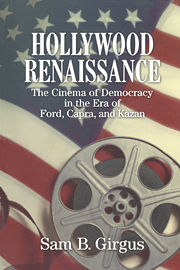Book contents
- Frontmatter
- Contents
- List of Illustrations
- Acknowledgments
- 1 Ethnics and Roughnecks: The Making of the Hollywood Renaissance
- 2 A Cinema for Democracy: John Ford and the Crisis of Modernity, Myth, and Meaning
- 3 Gender and American Character: Frank Capra
- 4 Revisioning Heroic Masculinity: From Ford to Hawks and Zinnemann
- 5 An American Conscience: Elia Kazan's Long Journey Home
- 6 Losing Tomorrow: George Stevens and the American Idea
- 7 Conclusion: Film and America after the Hollywood Renaissance
- Notes
- Filmography
- Index
7 - Conclusion: Film and America after the Hollywood Renaissance
Published online by Cambridge University Press: 05 June 2012
- Frontmatter
- Contents
- List of Illustrations
- Acknowledgments
- 1 Ethnics and Roughnecks: The Making of the Hollywood Renaissance
- 2 A Cinema for Democracy: John Ford and the Crisis of Modernity, Myth, and Meaning
- 3 Gender and American Character: Frank Capra
- 4 Revisioning Heroic Masculinity: From Ford to Hawks and Zinnemann
- 5 An American Conscience: Elia Kazan's Long Journey Home
- 6 Losing Tomorrow: George Stevens and the American Idea
- 7 Conclusion: Film and America after the Hollywood Renaissance
- Notes
- Filmography
- Index
Summary
When F. O. Matthiessen's American Renaissance appeared in 1941, Americans still were suffering from the worst economic depression in modern times and were on the brink of fighting the most extensive and deadliest war in all of human history. President Franklin D. Roosevelt described the ultimate danger from overseas in his “Arsenal of Democracy” fireside chat of 29 December 1940. A year before the attack on Pearl Harbor, Roosevelt told his radio listeners:
Never before since Jamestown and Plymouth Rock has our American civilization been in such danger as now. … If Great Britain goes down, the Axis powers will control the continents of Europe, Asia, Africa, Australia, and the high seas – and they will be in a position to bring enormous military and naval resources against this hemisphere. It is no exaggeration to say that all of us, in all the Americas, would be living at the point of a gun.
Summarizing conditions at home, Walter A. McDougall writes:
The 1930s were the first protracted period of economic contraction in U.S. history, and the first time that neither an open frontier nor an open world provided a safety valve. The West Coast was already settled, and the Great Plains a Dust Bowl. The collapse of credit and the rush to protectionism choked world trade. Savings disappeared, and not just traditional hard cases – Negroes and new immigrants – but even white farmers, factory workers, tradesmen, and shopkeepers despaired of opportunity. […]
- Type
- Chapter
- Information
- Hollywood RenaissanceThe Cinema of Democracy in the Era of Ford, Kapra, and Kazan, pp. 210 - 228Publisher: Cambridge University PressPrint publication year: 1998



